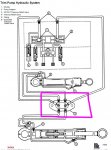sogood
Petty Officer 1st Class
- Joined
- May 11, 2016
- Messages
- 361
I recently took my boat ashore for some general repairs and maintenance. High on the list is finding where it's taking on water. Quite a lot of water as it happens. Details are it has an Alpha 1 Gen 1 outdrive, the leg on which has to be, (unfortunately) raised fully when moored, as my mooring drains dry on low tide.
The bilge was empty on low tide, but as soon as the tide rose, so also did the water in the bilge. My bilge pump, which had been working, seems to have failed just before the most recent ingress. So far, investigations have shown that the exhaust bellows was completely split apart, but this apparently, shouldn't allow water into the bilge.
As far as I can see, the U joint bellows is fully intact and tightly clamped, as is the shift bellows. Further investigation will follow when my hinge pin tool arrives, allowing me to dismantle things further.
I was going to allow some water to run into the exhaust outlet, from outside the boat, to see if it rant back inside into the bilge, suggesting an issue with the Y pipe. Thoughts on this or any other approach?
The entire leg assembly is securely bolted up to the transom, nice and tight, and I'm confident that it wouldn't allow such a volume of water into the boat. This all happened without the engine running and happened in tandem with the rising tide.
I've already checked any thru-hulls while the boat was afloat and these all check out fine.
The bilge was empty on low tide, but as soon as the tide rose, so also did the water in the bilge. My bilge pump, which had been working, seems to have failed just before the most recent ingress. So far, investigations have shown that the exhaust bellows was completely split apart, but this apparently, shouldn't allow water into the bilge.
As far as I can see, the U joint bellows is fully intact and tightly clamped, as is the shift bellows. Further investigation will follow when my hinge pin tool arrives, allowing me to dismantle things further.
I was going to allow some water to run into the exhaust outlet, from outside the boat, to see if it rant back inside into the bilge, suggesting an issue with the Y pipe. Thoughts on this or any other approach?
The entire leg assembly is securely bolted up to the transom, nice and tight, and I'm confident that it wouldn't allow such a volume of water into the boat. This all happened without the engine running and happened in tandem with the rising tide.
I've already checked any thru-hulls while the boat was afloat and these all check out fine.
Anywhere else I should be looking? Thanks in advance.





















